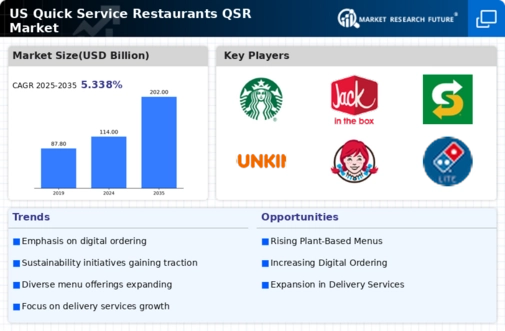Evolving Consumer Preferences
Consumer preferences are rapidly evolving, significantly impacting the quick service-restaurants-qsr market. There is a marked shift towards convenience and speed, with many customers prioritizing quick meal options that fit their busy lifestyles. In 2025, around 60% of consumers indicate that they prefer dining at establishments that offer fast service without compromising on quality. This trend suggests that quick service-restaurants must adapt their menus and service models to meet these changing expectations. Additionally, the rise of delivery services has further influenced consumer behavior, as more individuals opt for home delivery rather than dining in, thereby reshaping the market dynamics.
Focus on Menu Diversification
Menu diversification is increasingly becoming a focal point for the quick service-restaurants-qsr market. As consumer tastes evolve, restaurants are expanding their offerings to include a wider variety of cuisines and dietary options. In 2025, it is anticipated that nearly 50% of quick service-restaurants will introduce plant-based or alternative protein options to cater to health-conscious consumers. This trend reflects a growing awareness of dietary preferences and the demand for innovative menu items. By diversifying their menus, quick service-restaurants can attract a broader customer base and enhance their market presence, ultimately driving growth in the industry.
Competitive Pricing Strategies
Pricing strategies play a crucial role in the quick service-restaurants-qsr market, where competition is fierce. Many establishments are adopting competitive pricing to attract price-sensitive consumers. In 2025, it is projected that approximately 40% of consumers consider price as a primary factor when choosing a quick service restaurant. This trend compels businesses to offer value meals and promotions to maintain customer loyalty. Moreover, the ability to balance quality and affordability is essential for success in this market. As competition intensifies, effective pricing strategies will likely become increasingly important for quick service-restaurants to differentiate themselves and capture market share.
Expansion of Delivery and Takeout Services
The expansion of delivery and takeout services is a significant driver in the quick service-restaurants-qsr market. As consumer demand for convenience grows, many establishments are enhancing their delivery capabilities. In 2025, it is estimated that delivery sales will account for over 25% of total revenue in the quick service-restaurants-qsr market. This shift is prompting restaurants to partner with third-party delivery services and invest in their own logistics. The convenience of having meals delivered directly to consumers' homes is reshaping the traditional dining experience, making it essential for quick service-restaurants to adapt to this trend to remain competitive.
Technological Advancements in Ordering Systems
The quick service-restaurants-qsr market is experiencing a notable shift due to advancements in technology, particularly in ordering systems. The integration of mobile apps and self-service kiosks has streamlined the ordering process, enhancing customer convenience. In 2025, it is estimated that approximately 30% of transactions in the quick service-restaurants-qsr market occur through digital platforms. This trend not only improves operational efficiency but also caters to the growing demand for contactless service. As consumers increasingly prefer quick and efficient dining experiences, the adoption of these technologies is likely to continue rising, thereby shaping the competitive landscape of the industry.
























Leave a Comment